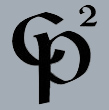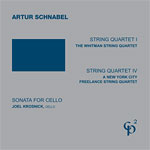
STRING QUARTET I
THE WHITMAN STRING QUARTET
STRING QUARTET IV
A NEW YORK CITY FREELANCE STRING QUARTET
SONATA FOR CELLO
JOEL KROSNICK, cello

 |
ARTUR SCHNABEL STRING QUARTET I THE WHITMAN STRING QUARTET STRING QUARTET IV A NEW YORK CITY FREELANCE STRING QUARTET SONATA FOR CELLO JOEL KROSNICK, cello |
 |
|
||||||||||||||||||||||||||||||||||||||||
|
•
The opening Allegro energico e con brio has the key signature of "d minor" for much of the movement, but the harmonies are extremely "extended". The pitches of the opening primary motive are highly similar to those of the Schoenberg Quartet IV (1936). These opening eight notes (7 pitches) restart the movement at least four times (at approximately 0:32'; 4:43'; 7:22'; and 10:43' within the movement) and therefore, one can think of the movement in five sections, each one (very) freely varying previously introduced material, as well as going off on tangents. The second movement (Andantino grazioso) is a mildly-demented Kreislerian Viennese Caprice, opening with a world-weary, wistful motive. This alternates with an "Amen" utilizing an initial triplet, which triplet becomes seminal, especially in the somewhat Ravel-like mid-section. To a large extent in G Major, the Larghetto waivers between extreme sadness, longing and hope. There are shades of the loneliness of Mahler's Wayfarer Songs, as well as a remarkable and prescient (for 1918) section of quartal and quintal harmony, which is preparatory to a large Hymn-like section (ca. 4:20'–5:40' in the movement). The movement then returns to loneliness, but its emotional life turns on a dime, into ecstasy and back, finally settling into a long peroration in G. There are glimmers of Puccini; certainly Busoni; perhaps it anticipates Bartok; but finally it is its own thing—a quite unique, personal, and coherent attempt to make an amalgam of the various compositional trends and conflicts of the 20 years previous to its writing. A rambunctious final Prestissimo begins with a unison whoop and holler, starting on an A flat, moving abruptly over the first five measures to a D natural. Most of what follows thereafter arises from that initial motive, and/or from the dichotomy of the harmonic teeter-totter based on the initial tritonal progression. No matter the time I spend with this quartet, and indeed with Schnabel's music in general (and by now that is simpler measured in months than hours) I still cannot satisfactorily answer "where does this music spring from". The cheap and easy comparison for this First Quartet is obviously the Schoenberg I, but that simply does not wash, as that is a far more conventional, traditional-in-structure, late Romantic, not-very-forward-looking, composition. Certain aspects of Busoni come to mind, but not to any great extent, although the general patina of, for example, the Busoni Second Violin and Piano Sonata (1898), is enlightening. Reger is not apposite, as Reger's harmonies (at least to me) are in virtually constant flux, where one barely touches a cadence without simultaneously departing elsewhere (the quintessential wonder is his On the Theory of Modulation (1903)—Captain Spaulding's equally wondrous and wonderful "Hello, I must be going" comes to mind). Schnabel's harmonies have much more stasis, in that he frequently seems to plant himself in two opposing tonal centers between which he sways or pivots. By this I do not mean bi-tonality, as that implies the simultaneous use of two clearly (or fairly clearly) defined "keys". Rather I mean two centers, or attractants, each with their own gravitational force, pulling pitches, or entire segments, one way or the other. Furthermore, unlike Reger, whose harmonies tend towards opacity, Schnabel's generally are more open, and the denseness is a result of extreme contrapuntal motivic conflation. One could continue to wonder about other influences (Hindemith and Krenek in Schnabel's early years) but in the final analysis, the compositional voice is unique. •
Movement two (Andante grazioso) is a slow and solemn dance (certainly not a minuet, but equally clearly not a scherzo) with very plastic metrical changes, with a middle section of "night music". The opening mood somehow reminds me of the beginning of the Zweiter Teil: Im Zeitmaβ eines langsamen, feierlichen Tanzes of Hindemith's Sonata in E flat major for Violin and Piano Op. 11, No.1 (1918). The third, and last, movement (Resoluto e fiero e con passione) of Quartet IV is structurally rather disjunct. The first violin begins with a most operatic solo—an almost-extemporaneous mad-scene. This is followed by a similar (but duo) statement on the part of the viola and cello. We proceed to a rollicking waltz, followed by a declamatory section (ca. 1:48'), which is followed by a section with many scales (ca. 3:14'), leading to a cantalena (almost reminiscent of Vaughan Williams' The Lark Ascending (1920) (ca. 3:40')), but with a very unsettling cello part (ca. 4:00'). Introspection follows; and then a recap of the operatic material (7:13'); then on to mayhem (ca. 8:00') and frolic. There is a development of the mad-scene, this time within a quodlibet or collage (ca 8:55') and a peroration starts shortly thereafter. The score includes two different endings for the movement. We present both of these, providing two versions of the complete movement. If AS could not, to his own satisfaction, decide the final gesture, it would be at best, in the context of a CD, presumptuous of us to do so. •
The Allegro con moto is (for AS!) a fairly straightforward presentation, with extensive development of the initial motive. The second movement (Allegretto) is a "Perpetuum Mobile", much of it in the lowest registers of the instrument, resulting in a most strange sonic landscape. The Larghetto is an extended, expansive, elegiac and serene slow movement such as Schnabel was past master of. The last movement (Vivace ma non troppo) begins as a resolute, joyous and affectionate parody of a baroque dance movement (albeit in •
PZ |
||||||||||||||||||||||||||||||||||||||||
|
||||||||||||||||||||||||||||||||||||||||
|
Publisher for all works: Peermusic Classical; please visit www.peermusicclassical.com For information regarding Artur Schnabel please visit: schnabelmusicfoundation.com All recordings were made at the Clinton Recording Studios, Inc., Studio A, in New York City STRING QUARTET NO. 1: June 9-12, 1998 STRING QUARTET NO. 4: March 27-28, 2000 SONATA FOR CELLO: April 27-28, 2000 Produced and engineered by Paul Zinman CP2115/116 |
||||||||||||||||||||||||||||||||||||||||